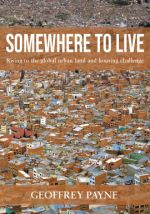Somewhere to Live: Rising to the global urban land and housing challenge

This book by housing and urban development consultant Geoffrey Payne seeks to call more attention to housing issues – especially those in cities in the global South. Part One reviews key issues and how they relate to urban land and housing. This includes the central question of how land and housing are valued, which is explored through case studies in Part Two. Part Three provides a range of options and examples that offer ways forward; how, in the author’s words, to ‘turn a [housing] crisis into an opportunity’. Woven into the text of many of the chapters is specific discussion of COVID-19 and needed responses.
After the overview given in Chapter 1, the second chapter explores the cultural factors that exert powerful influences over the environment and values that affect it. Chapter 3 considers how climate change impacts on housing and urban areas and examines who is at most risk. Chapter 4 explores the increasing levels of global and local inequality – and how this has made access to decent housing impossible for large sections of the population in all countries.
The fifth chapter reviews the ways in which the combination of social unrest, economic inequality and the climate crisis are generating increased levels of migration, and the impact that this is having on urban areas. Payne outlines how responses by host governments and communities have varied widely but tend to focus on attempts to control numbers without addressing the causes. Part One concludes with a discussion of how development proposals reflect the aspirations of an affluent minority, or authoritarian leaders, rather than responding to the needs of the majority.
In Part Two Payne moves discussion to the evolving debate about land tenure and property rights, and the political economy of urban land and housing. He focuses on how land and housing are defined and valued, socially as well as economically, and draws on a range of country case studies that provide examples of feudal, state-led, market-led, religious and customary systems of land and housing management These include state land and housing management in China, Cuba, Ethiopia and Vietnam; from state to market in Mongolia, Albania and Cambodia; and from customary to market in Lesotho and Vanuatu.
Building on the evidence presented in Parts One and Two, the chapters in Part Three focus on what needs to be done to meet the needs of all social groups in both the global South and North for access to adequate housing and a sustainable quality of life – observing that addressing inequality and the climate crisis raises the basic question of what we mean by development and how to measure progress. Chapter 13 explores the distinction between needs and wants, and the remaining chapters report on a wide range of innovative and progressive policies and projects that demonstrate how a decent quality of life and somewhere to live can be achieved for all.
Book note prepared by David Satterthwaite.
Search the Book notes database
Our Book notes database contains details and summaries of all the publications included in Book notes since 1993 - with details on how to obtain/download.
Use the search form above, or visit the Book notes landing page for more options and latest content.
For a searchable database for papers in Environment and Urbanization, go to http://eau.sagepub.com/

